February 10, 2023
All About our Chickens
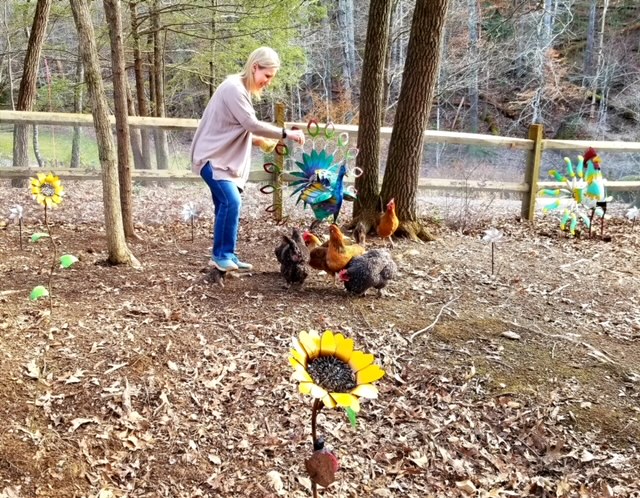 We recently had a surprise cold snap. Of course Jack was out of town, so keeping the chickens healthy and happy was my responsibility!
We recently had a surprise cold snap. Of course Jack was out of town, so keeping the chickens healthy and happy was my responsibility!
The first frigid morning, the sliding door to their coop was frozen shut. Eddie
kindly came to our rescue and opened the door and broke the ice on the chickens’ drinking
water. However they remained huddled in their little coop, not braving the cold even for a drink
of water. So of course, I served them their breakfast food and beverage “in bed”! The chickens have come to expect pampering, I guess.
Eddie, with assistance from Jonathan, built a fenced in play yard for their free-range time. They free-range in the late afternoon as the conventional local wisdom is that day predators will be sated by then and night predators will not have started hunting yet. We found a place in Cosby, TN, with metal art, so promptly brought home pieces of yard art to decorate their space.
The chickens eat a well-balanced organic layer feed. Their daily treat is a mix of protein flakes, dried mango, dried peas, and pumpkin seeds. It looks pretty tasty! I also grow them a variety of sprouts—clover, alfalfa, mung bean, barley, and rye. If I don’t sprinkle out the sprouts fast enough, Benedict leaps up to take them from my hand.
Benedict is not our only athletic chicken. I thought Hazel would be too plump to fly,
but I was wrong. We had a guest arrive in a helicopter this summer and the chickens got quite
excited. When I came that evening to feed them, Hazel surprised me from behind, leapt onto
my shoulder, and proceeded to beat me about the head with her wings. The harder I tried to
brush her off, the more she dug her feet into my shoulder. When I finally pried her off, she looked at me as though she were saying “You need to take better care of us!”
Hmmm, so far two of our chickens can do tricks. If I get Poached, Scrambled, Quiche, and Omelet to follow suit, we could have a vaudeville act!
We have learned that happy chickens reward us with lovely eggs! They c0me in dark chocolate brown, brown spotted, blue, green, and pink. They have brilliant orange yolks and are
delicious. I hope you will have a chance to try some when you are here.
April 11, 2022
Diary of a Mad Chick Mom
I grew up on a farm, so intellectuallyI knew that young chickens can be high maintenance and grow up into messy adults. But when Jack suggested we get chickens, all I could seem to think of was cute little balls of fluff.
So we journeyed to the Smoky Mountain Farmers Co-op to select our little flock. There are seemingly endless varieties of chicks. http://Www.starmilling.com We chose three French Marans (black) and three Wellsummers (brown). We named them Quiche, Omelet, Benedict, Scrambled, Poached and Hazel. Why didn’t Hazel get an egg-dish for a name? Because she quickly set herself apart as you will soon understand.
The Chicks Come Home
On the drive home I held the box of chicks on my lap. They were all cheeping contentedly, except for Hazel, who complained loudly the entire trip. We had a cozy brooder set up for them in our garden shed with soft bedding, a heater, water and chick feed. The minute I set them in their new home, five of the chicks began exploring. The sixth chick, Hazel, began flying at the other chicks, trying to peck their eyes out. To my horror, I watched the other chicks try to hide behind Omelet, who had a large, bleeding gash beneath one eye, as Hazel flung herself at them again and again.
At about that time our poultry mentors, Jonathan and Morgan, arrived to see our new birds. None of their chicks had ever been set on destruction like Hazel seemingly was. They promptly dubbed her the Murder Chicken.
I couldn’t let Hazel blind my entire flock so I did the only thing I could think of—I put her into solitary confinement. Her cell was a cardboard box with bedding, food and water. I put it near the heater so she could stay warm. Hazel was very unhappy and kept flinging herself at the walls of her jail. I assumed she would soon calm down. So we left the brooder. And Jack left for a business trip to Chicago leaving me in charge of our little chicks. I did some research and found that chicks sometimes mistake the eyes of other chicks for bugs and try to peck them. Thankfully, they seem to grow out of this phase quickly.
The next morning Hazel was still disconsolate. She had not calmed down. By the amount of bedding in her water, it seemed as though she had been throwing herself at the walls all night long. I cautiously returned her to the general population. I watched for a long time, and she did not attack any of her brooder mates. Perhaps everything was fine and dandy in Chick World? It was not.
Chick Spa Setup for Hazel
When I checked on them in the afternoon, I noticed something odd about Hazel’s profile. Again I turned to the internet and found that stress can cause a condition that the English call “Pasty Bum”. Basically stress upsets their little digestive tracts and makes the chick’s droppings pasty. The dropping then clog the chick’s elimination vent. Without care, they will die within a few days. Oh dear.
I read about caring for this condition. I didn’t like what I read, so I read some more. Finally I realized there was nothing to do but follow the recommended protocol. I held Hazel’s little bottom under a gentle stream of warm water and used a soft cloth to clean her backside. I dried her with a fluffy towel. And then I used my hair dryer set on low to dry her fluff. It takes a surprising long time to dry a chick, so I had plenty of time to think. My thoughts ran along the lines of “I used to be a CEO of a $40 million organization. I used to attend galas and cocktail parties. And now I am spending my evening blow drying a chick’s bottom.”
Apparently this is not a one and done treatment. So Hazel and I developed a routine. When I walked into the shed I could almost hear her groan. She would try to evade me, but once caught would quietly submit to my ministrations. Day two involved a sitz bath in one of my grandmother’s berry bowls. By day three I was able to clean her with a wet cloth and apply the tiniest bit of Crisco to her vent with a cotton swab.
After a week of daily cleanings, Hazel was finally back to normal. And Jack was back from Chicago. I was eager to show him how much the chicks had grown. He looked at them and said “Now that we are good at raising chickens, maybe we should get some goats.” ???????!!!!!!!!!!
August 17, 2020
Wild Turkeys Alive and Well in Tennessee
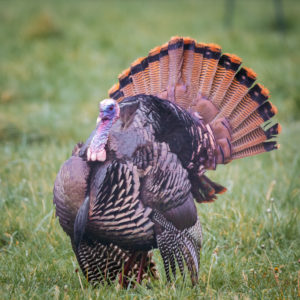
A male eastern wild turkey spreading his tail feathers on an overcast morning in Cades Cove, Tennessee
At Buckhorn Inn we have two wild turkeys who frequent the area below one of our bird feeders. We were interested to learn more about them, and thought you might be, too.
According to the Tennessee Wildlife Resources Agency, http://www.tn.gov/twra/wildlife/birds, wild turkeys are the largest birds nesting in Tennessee. These birds were a very important food source to Native Americans and early settlers. Unfortunately, over-hunting and land clearing reduced the numbers of this species. Wildlife management techniques have reestablished the birds through their historic range.
The birds are found in mature woodlands or fields. They eat acorns, nuts, seeds, fruits, insects, buds, fern fronds, and salamanders. The males begin strutting to attract females in late winter and early spring. The female, with no help from the male it should be noted, makes a ground nest and lines it with with leaves and grass. The nest is usually at the base of a tree or bush and hidden by thick vegetation. The female lays anywhere from 7 to 14 eggs and incubates them for about 28 days. The young leave the nest soon after hatching. The male young stay with the female until fall while the females remain with their mother until spring.
Fun Facts about Tennessee Wild Turkeys
- There are approximately 300,000 of the birds in Tennessee.
- The average male weighs 16.2 pounds and the female weighs 9.2 pounds.
- The male provides no care to the young.
- Several females and their broods may form flocks of 30 or more birds.
The birds can be seen throughout the Great Smoky Mountains National Park, most often in the lower elevations. They roost in trees, so you are less likely to see them in the evening. Good places to spot them are the open fields near the Sugarlands Visitor Center and the Cades Cove Loop Road. Or you may just see them hanging around Buckhorn Inn!
January 23, 2018
Swans Set to Return to Buckhorn
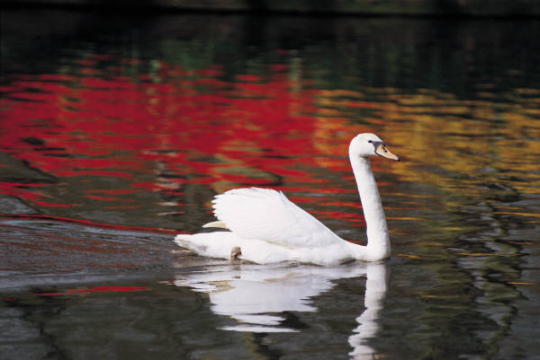 Many of you shared our heartbreak at losing Teller and his mates. But we are delighted to announce that two new swans will be joining us as soon as it is warm enough for them to be flown from Chicago.
Many of you shared our heartbreak at losing Teller and his mates. But we are delighted to announce that two new swans will be joining us as soon as it is warm enough for them to be flown from Chicago.
Mute swans are at their most vulnerable during the nesting season. While our swans had a nesting box in a safe location in the pond, they insisted on nesting on the shore where they could become prey to coyotes and bears. When defending a nest they do not swim to safety. We knew that swans are happiest in pairs, and we could not face losing more swans and their cygnets. What we recently learned, however, is that same-sex swans form strong partnerships with each other. Therefor our new swans are two brothers who, our vendor assures us, are already bonded. Minimal sibling rivalry here!
Guests sometimes ask us why the swans are called “mute” swans. The answer is that they are much less vocal than other swans. That does not mean they are silent thought! Mute swans make a variety of sounds that could be called grunting, snorting, whistling, chirping, squawking, and hissing.
Swans are beautiful and graceful birds. In England, swans are considered royal birds and all swans in open waters belong to the crown. For many centuries, mute swans were raised for food with individual birds being marked on their feet or beaks to indicated ownership. These marks were registered with the Crown and a Royal Swanherd was appointed. Any birds not marked became property of the crown, thus leading them to be called royal birds. Mute swans were introduced to North America in the late 19th century. In the United States, swans were nearing extinction as recently as the 1930’s. Thankfully preservation efforts have allowed their population to grow again.
If you are not familiar with swans, here are some fast facts to “pre-introduce” you to our new guests!
• Mute swan fossils 6,000 years old have been found in post-glacial peat beds in Great Britain.
• Adult mute swans typically range from 55 to 63 inches long with a 79 to 94 inch wingspan.
• Mute swans are the second largest waterfowl after the trumpeter swan.
• The mute swan is one of the heaviest flying birds with a weight range of 20 to 32 pounds.
• They feed on a wide range of vegetation, both underwater plants and land plants.
• The swans’ threat display is called “busking”. A busking swan curves its neck back and half-raises his wings. Swans also use this pose to “windsurf” across bodies of water.
• The fairy tale “The Ugly Duckling” by Hans Christian Anderson is the story of a cygnet who is perceived to be ugly by his fellow fowl. Eventually he matures into a graceful swan, the most beautiful bird of all.
• In the ballet “Swan Lake”, the main character and her companions are turned into swans by a wicked spell.
• The mute swans in the moat at the Bishops Palace at Wells Cathedral in England have been trained to ring bells to beg for food. Swans have been trained there in this way for centuries.
The swans will have a beautiful home. Over the winter we have installed a fountain to help the pond stay healthy and to provide soothing sound; removed fallen trees and brush; and installed many new plantings. The plantings include evergreens to screen the pond from Buckhorn Road, flowering trees and bushes, and perennials to provide season-long color. Our spring-fed pond will be one of your favorite places on our property!
Watch future newsletters and ou to be among the first to know when our swans arrive! We also will provide instructions for accessing our “Swan Cam” so you can keep abreast of their activities from wherever you happen to be.
April 12, 2014
Join a Birding Expedition at Buckhorn
Where: Right here at Buckhorn Inn. This is bird heaven. Please see our publication about bird life on this property.
When: Thursdays and Saturdays at either 7:30 (before breakfast) am or 8:30 am (after an early breakfast). Must reserve in advance.
Length of Birding Adventure: 1½ Hours
Cost: $15 per person or $25 for two (minimum of three persons required)
How to Register: Inn Office; 24 hour cancelation required.
Rain: Significant rain will result in cancellation
Expert Birder Keith Watson will lead the adventure
May 23, 2013
A Room Full of Birds
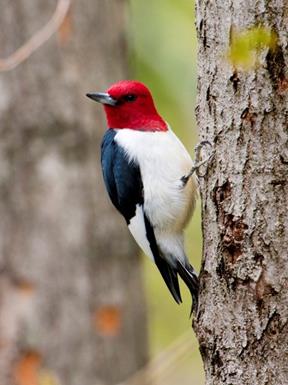
Come see our great photo exhibition of the work of David Kelch entitled “A Room Full of Birds.” David is a nationally recognized photographer with oodles of talent. This photo of a red-headed woodpecker is his latest. This exhibit is one of the many activities we are sponsoring as a part of our 75th Anniversary Celebration.
February 24, 2011
What’s that twittering?
What’s that song I hear? According to the Great Smoky Mountains Association, it may be the Louisiana Waterthrush, the Blue-Gray gnatcatcher, the Yellow-throated Warbler or the Blue-headed Vireo (pictured here). These are among the Smokies’ early spring arrivals whose songs can fill the air in late February and March. The next time you visit Buckhorn, check out our list of birds which inhabit our grounds. If you would like to have a “bird tour,” we can arrange for a naturalist to take you out for a bit of bird spotting. Or stop in the kitchen for a visit with Chef Robert Neisler who is our resident bird expert.



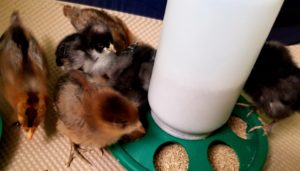
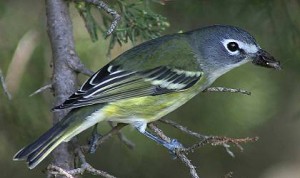
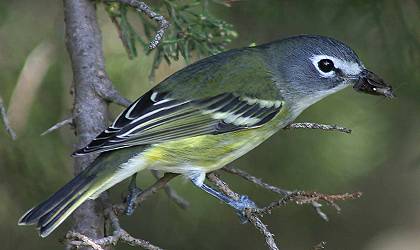

Gatlinburg Weather
Click for weather forecast